Full Name Guity Navran Role Artist Nationality Canadian-Iranian Education Bachelor of Arts | Movement Transpressionism Name Guity Novin | |
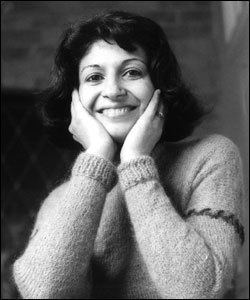 | ||
Notable work Oil, Watercolor, Mix media, | ||
Known for Painting, Graphic design | ||
Guity Novin (born Guity Navran, 1944) is an Iranian-Canadian figurative painter, and graphic designer residing in Canada. She classifies her work as Transpressionism, a movement she has introduced. Her works are in private and public collections worldwide.
Contents
- Life and work
- The formative years 19531970
- Early period 19701976
- Exhibitions of paintings 19711976
- Reviews
- European period 19751980
- Early Canadian period Kingston Ottawa and Montreal 1980 84
- Ottawa period 19841997
- Vancouver period 1996 onwards
- Graphic designs
- Backlash
- Transpressionism
- References
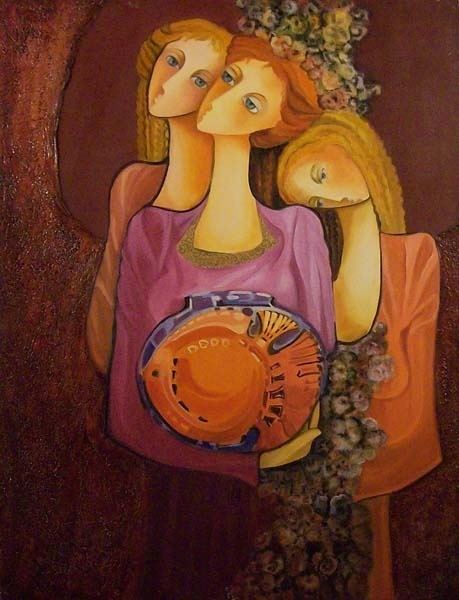
She has served on a UNESCO national committee of artists.
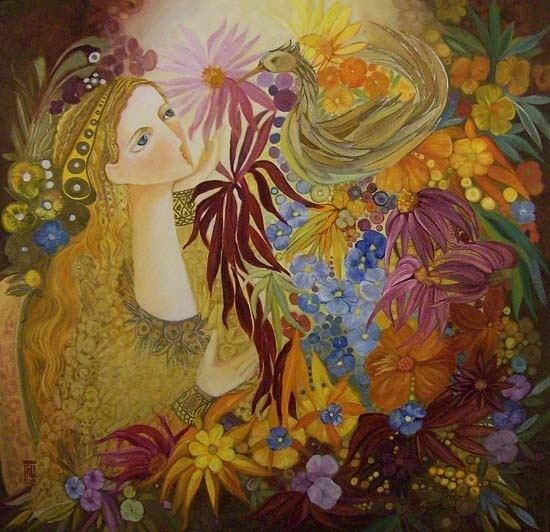
Life and work
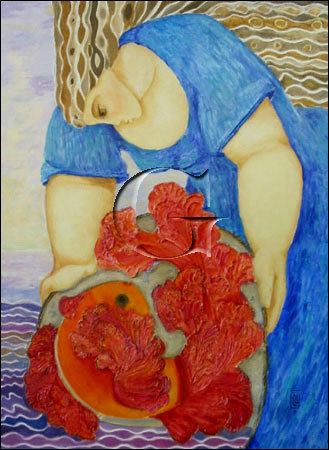
Guity Novin was born in an educated middle-class family in Kermanshah. Her family were originally from the northern Iranian city of Bandar Anzali. Her father Abdol-Rahman Navran was the only son of Abodl-Rahim, a ship owner and sea merchant in the northern Iranian port of Anzali (Bandar-e Anzali) in the Caspian Sea. He traded between ports of Baku, Lankaran and Astara in Azerbaijan. In the early 20th century the Caucasian region became a major geostrategic center and one of the important theaters of World War I. After the October Bolshevist coup and civil war in the former czarist Russia, the Red Army conquered Baku in 1918, the navy of the White Army took refuge in the Anzali Port, which was under the control of British forces. The Red Navy conquered the port of Anzali in 1921 and confiscated Abdol-Rahim's ships. These events financially ruined Abdol-Rahim as he soon lost his capital and watched his business collapse. Seeing no prospects of recovery, the young desperate businessman committed suicide. His young son Abdol-Rahman was raised by his Navran grandparents, and was separated from his young mother, who soon was remarried and gave birth to another son Djavad Bani-Yaghub. After finishing high school, sought independence Abdol-Rahman found a job in order to be independent. He was offered a post at the Iran Customs, and was sent to work at its branch office in Ghasr-e Shirin, a border post with Iraq. Abdol-Rahman who learned to play accordion, spent his weekends at Kermanshah, where he fell in love with a sister of one of his colleagues, a local beauty by the name Molook Kashefi. Soon after they met, he proposed and she accepted. Together they had four children, Guity, who was the eldest, Kamran, her brother, and her two younger sisters Jaleh, and Jila. Meanwhile, Abdol-Rahman brought his mother and his younger brother to live with him. His mother never left him again.
The formative years 1953–1970
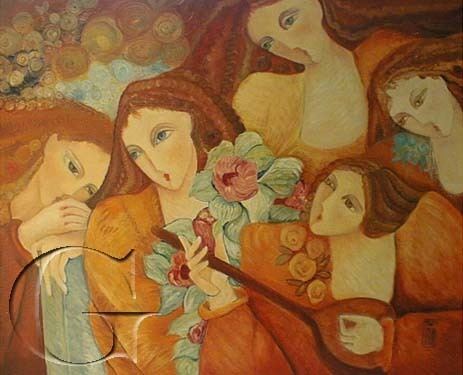
In the spring of 1953, the Navran family moved to Tehran. Those were tumultuous years for Iran, the nationalist Prime Minister, Dr.Mossadegh, had nationalized the oil industry in 1951, and now the confrontation between Iran and Britain have escalated to the extent that the Iranian government refused to allow the British any involvement in Iran’s oil industry, and Britain was making sure that Iran could not export any oil. Mossadegh had stopped negotiations with Anglo Iranian Oil Company [AIOC] and the British government had announced a de facto blockade of Iran and reinforced its naval force in the Persian Gulf and lodged complaints against Iran before the United Nations Security Council. On 4 April 1953, CIA director Dulles approved a plan to oust Mosaddegh. The plot, known as Operation Ajax, succeeded and Mosaddegh was ousted. During these turmoils, the young Guity was hearing an array of disturbing news without being able to make much sense of them. For instance, she overheard from adults that the head of Police had been kidnapped and was tortured to death, this had frightened her enormously.

Guity was sixteen years old that her art teacher at Asadi High School in Tehran noticed her talent and suggested to her that she should apply for admission to the Girl's College of Fine Arts in Tehran. She was admitted there and was graduated in 1965. This was an important steppingstone for being admitted to the Faculty of Decorative Arts in 1970. About her academic experience, later on she wrote:
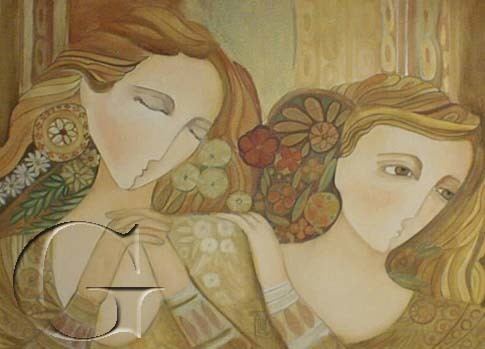
After her graduation, Guity married Farid Novin, an economist, and she mothered three sons Saladin, Alamir, and Alishah.
Early period 1970–1976
After graduating from the Faculty of Fine Arts with a BA in graphic design, Guity Novin was employed as a graphic designer in the Department of Graphic Arts at the Ministry of Culture and Arts (MCA) in Tehran, in 1970. However, as the first female graphic designer she immediately was confronted with various barriers and adversarial relationships. All the important posters were designed by the head of the department, who had at his disposal the services of many calligraphers, drawers, and other designers. Guity responded by creating her own innovative posters outside the MCA and for the private sector. The young film makers of the Free Cinema of Iran, under the management of Basir Nasibi, commissioned her to design the cover of their first two books, as well as some of their posters. Pretty soon her posters and line drawings was reproduced on the cover of cultural magazines, such as Negin. She also began to design the cover of magazines like Zaman, and various literally periodicals such as Chaapar, and Daricheh. Fortunately for Guity, the late Hajir Darioush, a young new wave director of cinema, was assigned as the president of First International Film Festival of Tehran which was headquartered at the MCA. Noticing Guity's talent, Darioush invited her to join his team, and Guity produced the catalogs and posters of the festival.
Exhibitions of paintings, 1971–1976
In 1971 Afsaneh Hoveida, the French curator of the prestigious Negar Gallery, invited Guity to exhibit her works at the Gallery. Guity exhibited her paintings under the title of Expression of Silence, which was inspired by the poems of Omar Khayyám in 1971. Her next two exhibitions; Posthumous, a journey to the poetical spheres of Ahmad Shamlou in 1973, and Tana Naha Yahu, Songs of Dervishes in 1975 inspired by the poems of Rumi, were held at the Seyhoon Gallery.
In addition she participated in numerous group exhibitions such as the Women artists exhibition during Asian Games of 1974. As well, She exhibited in the Salon d' autumn, Paris.
Reviews
Mansooreh Hosseini reviewed Expression of Silence:
Firoozeh Mizani interviewed Guity for Tamasha:
European period, 1975–1980
In 1975 Novin moved to The Hague, the Netherlands, studied at Vrije Academie voor Beeldende Kunsten, and exhibited in 1975 at Noordeinde Gallery. She named ths exhibition Melodious Spheres. She moved to Manchester, England, in 1976, exhibited her "In Essence" show at Didsbury Library and was selected in 1979 for the E.C.A Exhibition at National Theatre, London. She also participated in several group exhibitions.
Early Canadian period, Kingston, Ottawa, and Montreal, 1980-84
In 1980 Guity settled in Kingston, Ontario. Her first exhibition in 1981 at the Brock Street Gallery in Kingston was called Lost Serenade. The Whig-Standard magazine, published her work "Flute Player" on the cover its October 3, 1981 issue, and Don McCallum reviewed it in the same issue. He wrote:
, and Frank Berry wrote:
During this period she also exhibited at galleries in Ottawa, Montreal, and Toronto.
Ottawa period 1984–1997
Guity spent 1983 in Montreal, and then in 1984 she and her family relocated to Ottawa, where she worked and exhibited until 1997. With a couple of her artist friends, including Raku potters Huc Wee and Adrianne Lamoreaux, Novin established the Artex Gallery at the Byward market in Ottawa where she painted and exhibited her works. At the same time, she started to produce graphic art drawings for the Breaking the Silence, a feminist periodical. Her illustrations were published in Le Carnaval de la licorne (2001), and her work Pears in Blue was published in Abnormal Psychology. Chapters bookstore exhibited her works in their main bookstore in Ottawa in 1995, and she participated in the National Capital Fine Art Festival at Aberdeen Pavilion, Landsdown park in March 1996.
Vancouver period, 1996 onwards
Guity Novin moved to Vancouver in 1996. She worked and exhibited as a resident artist in the Guthenham Gallery in Granville Island during 1997-2000. From 1996 onwards in a series of shows, she called her style as Transpressionism, and viewed it as a new initiative in art. Solo shows in this period include The Bliss of Solitude (2004), And Yet the Menace of the Years Find, and Shall Find, Me Unafraid (2006), Whispered of peace, and truth, and friendliness unquelled (2007), 'She opened her door and her window, And the heart and the soul came through" (2008), and "but love is the sky and I am for you, just so long and long enough" (2009) (All at North Vancouver Community Arts Council, "Art in Garden"). She also participated in a number of group shows, including two shows at the Ferry Building Gallery in 2006 and 2008, and in the CityScape gallery in 2009.
Graphic designs
Guity novin worked as a graphic designer. She has created posters and magazine covers in Iran during the 1960-70 period. From the inception of the contemporary Iranian communication design activities in the 1960s, Guity Novin, was among its early practitioners which included graphic designers like Morteza Momayez, Farshid Mesghali, and Ghobad Shiva. These artists looked at graphic design as a conduit for the expression of their artistic aestheticism in the context of the Iranian visual grammar. Of course, for the male pioneers, like Momayez and Shiva, the path was somewhat smoother, as they were fortunate enough to work for institutions that allowed them a considerable level of artistic liberty. But for Novin, as a female practitioner the path was much harder. The number of such progressive institutions were very limited and most of the private sector clients, motivated only by profit, were satisfied by the work of visual designers who were just plagiarizing the prevailing styles in the western media. In fact, for many bureaucrats and business managers the notion of female artists at the helms of a graphic design department was a hard concept to swallow. For instance, soon after Novin started her career at the Iranian Ministry of Culture and Art, she was confronted with the fierce opposition of the head of the graphic design department. A graphic designer himself, the head expected Novin to assume the administrative tasks of the department. It was the late Hajir Darioush, a New-Wave Iranian film director, who noticed Novin's talent and offered her the position of the graphic designer in his department. It was there that she produced the posters, leaflets and the catalog of the First Tehran International Film Festival.
Novin has illustrated the covers of magazines like Negin and Zaman; and the publications of the Free Cinema of Iran. She was also the graphic designer of the First Tehran International Film Festival. In Ottawa her illustrations were published in the Breaking The Silence Magazine during the 1980s. In Canada, Novin continued to produce posters for various social causes. She also has authored A History of Graphic Design, an online eBook.
Backlash
In the early 2012, a widespread campaign in a large number of Iranian media against Guity Novin started, attempting to create doubt about her as an existing real person. These articles distorted a report by the Jerusalem Post entitled "The World's 50 Richest Jews", published September 7, 2010, with an altered heading that read Introducing the World's Richest Zionists. The doctored article claimed that: "The ninth richest Zionist is Carl Ichan, of Iranian origin, whose Persian name is Guity Novin (Navran), who was born in Kermanshah, and now resides in Canada with a worth that is announced at more than $14 bn." However, the ninth person in the Jerusalem Post article was actually John Paulson, and Carl Ichan name was not in the list. In her response Guity Novin wrote on her blog: "I admit that I have many Jewish friends who do like my works, but the last time I checked this was not illegal. I admit that I am a woman painter. I admit that I am among the first graphic designers in Iran, I was one of the first instructors of graphic design who trained many students. I was the graphic designer of the first Tehran International Film Festival -- that's before the late Morteza Momaiez, the father of graphic design in Iran. I designed the cover of Negin before he did his." and demanded "can somebody please let me know why am I subjected to these kinds of misinformation?" None of the aforementioned media retracted.
Transpressionism
Guity Novin founded Transpressionism in 1994 in opposition to High modernism, aiming to interpret humanism and acroamatics values with aesthetic notions of beauty, harmony and transcendence. It counters what is perceived as the deathtrap of the artificiality of postmodernism by seeing art as a birth, where the viewer must be involved in the creation of the sublime. The artist's role is as a conduit for the observer’s imagination, where "Love" is the fundamental principle giving coherence to an otherwise random physical and psychic universe. To achieve this, Transpressionism makes use of legends and myths such as Clytie, a maiden who loves the Sun-god Apollo and is transformed into a sunflower.
Novin explained her motives for introducing Transpressionism:
Artists identifying with transpressionism include Fer Veriga (Brazil), Irina Kupyrova (Ukraine), Diana Zwibach (Yugoslavia), Terri Baugh-Norman (USA), Lorena Kloosterboer (Netherlands), Ellen Marlen Hamre (Norway), and Shano (USA).
